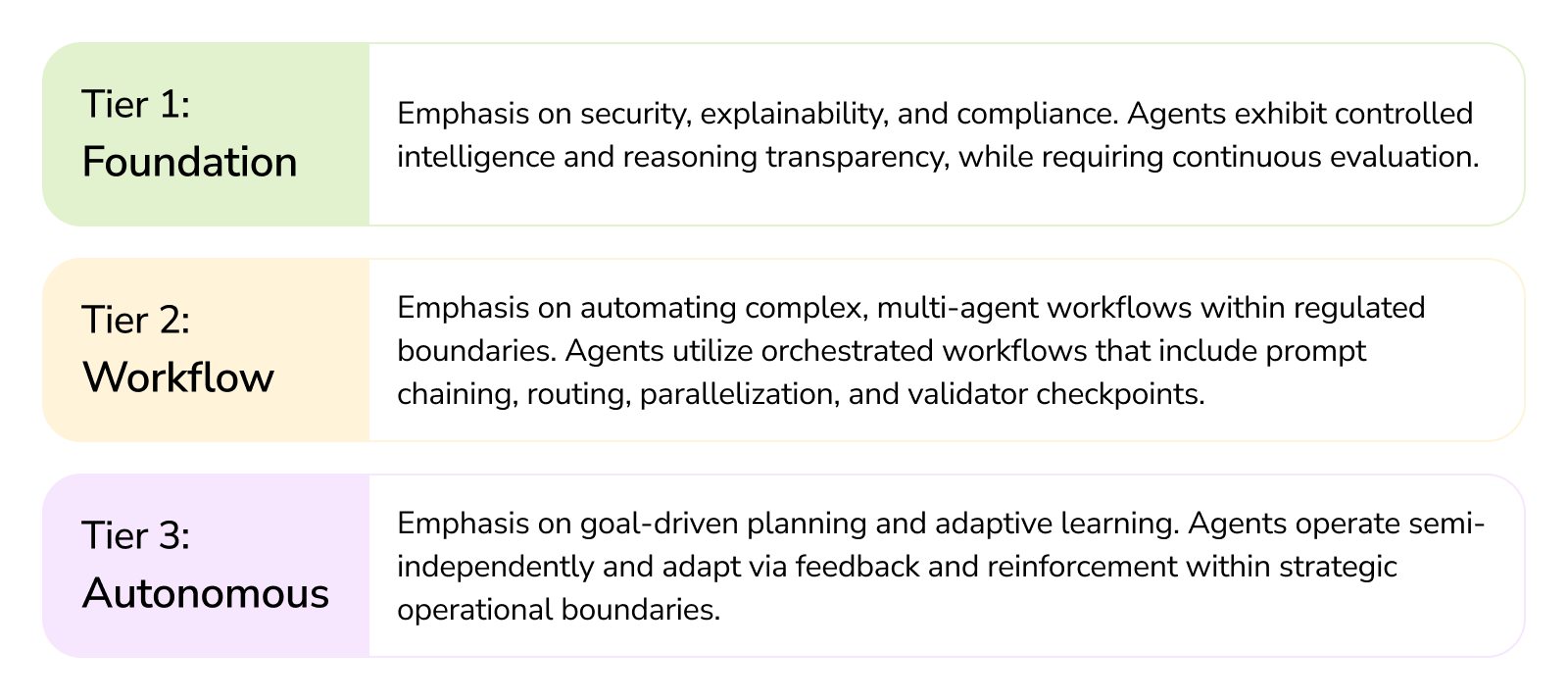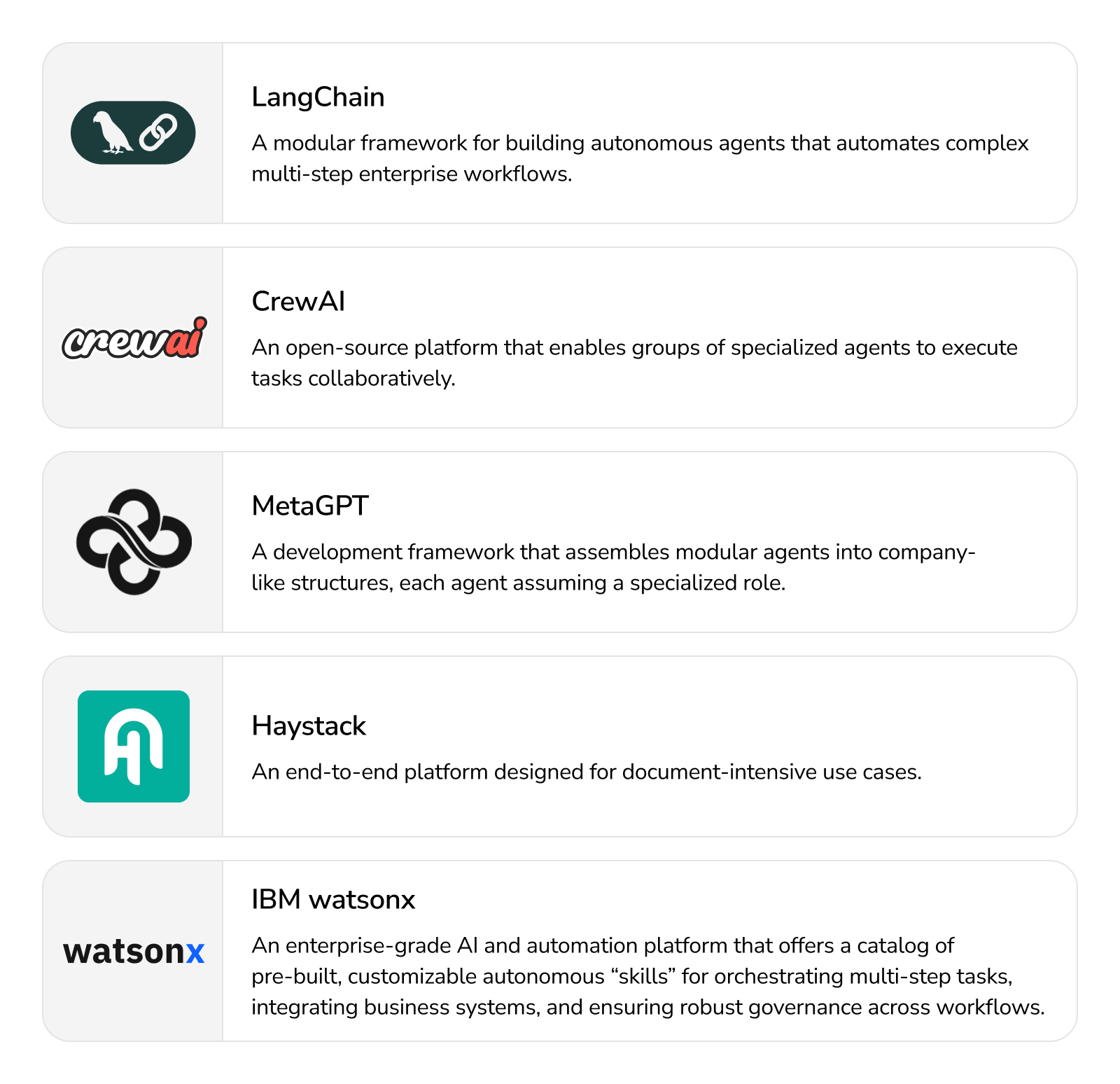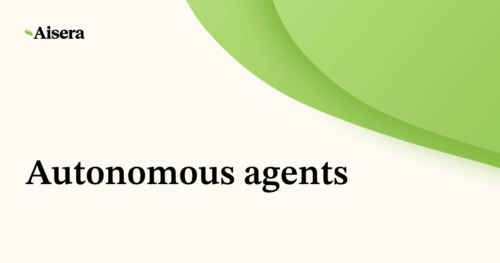Introduction to Autonomous Agents
Autonomous agents are advanced AI systems designed to independently perceive, reason, and act to achieve specific goals without constant human intervention. Unlike traditional automation that follows rigid scripts, these agents use Large Language Models (LLMs) and machine learning to adapt to new information, make decisions, and execute complex workflows on their own.
Why Autonomous Agents Matter Now
For business leaders and technical teams, the shift to autonomous AI represents a move from “assisted work” to “delegated work.” By handling the continuous stream of manual, mundane, and routine tasks that often clog service desks, these agents free your workforce to focus on high-impact strategy rather than repetitive execution.
In this guide, we will explore the architecture of autonomous agents, how Agentic AI functions within enterprise ecosystems, and how businesses can deploy these tools to scale operations efficiently.
What Are Autonomous Agents?
Unlike traditional automation or basic AI systems, autonomous agents do not follow strictly programmed instructions. Instead, they devise their own strategies to achieve their stated goals, learning and improving over time with minimal human intervention.
Agent autonomy is crucial, as it requires establishing clear operational boundaries and ethical considerations to ensure transparency and accountability. To achieve their goals, these agents break down complex objectives into smaller, assigned tasks, which they independently understand, prioritize, and execute.
Core capabilities of autonomous AI agents
Machine learning, large language models, and natural language processing (NLP) are key technologies that enable these agents to understand and respond to human language effectively. Advanced AI agents may also feature natural language understanding, allowing them to interpret user commands and automate workflows.
Autonomous AI agents are differentiated, as the name suggests, by their autonomy. This autonomy isn’t an abstract concept, but a combination of concrete capabilities that, together, reduce the need for human oversight. These capabilities include:
- Adaptive learning from past interactions through reinforcement learning, feedback analysis, or other mechanisms
- Complex decision-making is enabled by advanced reasoning capabilities, allowing autonomous agents to perform complex tasks through data analysis, context interpretation, and the ability to dynamically select actions
- Memory and recall, which enable the agent to refine future responses and maintain continuity over long interactions
- Multimodal perception involves processing and understanding inputs from multiple sources to allow more effective interaction with the environment
- Tool integration and the ability to orchestrate external resources to gather more information and perform more specialized actions
Types of Autonomous AI Agents
Autonomous agents aren’t a monolithic category. Because they’re adaptable and goal-oriented, they can operate using a range of patterns, methods, and architectures. Among these, simple reflex agents are a foundational type. Simple reflex agents operate by responding directly to environmental stimuli, acting based on predefined rules that dictate their behavior in specific situations. Here are some of the most common approaches.
Reactive agents
Reactive agents respond to immediate sensory input and have no internal memory or model of the environment. Because they operate on immediate, predefined responses to specific stimuli, they’re well-suited for predictable and fully observable environments. For example, a reactive alerts agent for IT can autonomously escalate network alerts to relevant teams when a given metric exceeds a specific threshold.
Proactive agents
Proactive agents anticipate future states or challenges rather than waiting for stimuli. These agents can plan actions to either prevent issues or exploit opportunities. A proactive agent for customer service can analyze user behavior in real time, such as prolonged inactivity or repeated failed login attempts, and automatically provide timely support or self-help suggestions for customers before escalation.
Goal-driven agents
Goal-driven agents, also known as goal-based agents, are among the most common autonomous agents. They evaluate possible actions and their implications for reaching a target state. As the environment or goals change, these agents can adapt their strategies and optimize their actions. For example, goal-driven agents in marketing can autonomously manage campaigns, tailoring content, distribution channels, and audience targeting based on the brief provided.
Deliberative agents
Deliberative agents build and use internal representations of their environments to reason, plan, and make decisions. They often consider multiple possible actions and outcomes before taking action. Deliberative agents, for instance, can model complex IT infrastructure environments, considering various potential failure points and their cascading impacts. They then simulate different recovery strategies, evaluating trade-offs in downtime, resource allocation, and cost.
Model-based agents
Model-based agents work best in environments that are only partially observable; these agents will model the rest of the environment as a way of “filling in the blanks.” This makes them more adaptable and versatile than reactive agents. One of the AI agent examples is an inventory optimization agent that can predict demand by modeling purchase histories and external factors, creating autonomous strategies for procurement and distribution.
How Do Autonomous AI Agents Work?
Typically, autonomous agents’ architectures fall into one of three maturity tiers, each of which increases their autonomy and decreases the need for human intervention:

Components
Regardless of which maturity tier an autonomous agent operates under, it consists of the same four components. Task management is a key function of autonomous agents, enabling them to efficiently handle task creation, prioritization, and execution within automated workflows.
0. Planning
The planning component is responsible for breaking down larger goals into smaller, manageable tasks—a process known as task planning. This core capability allows autonomous agents to optimize workflows, adapt to changing requirements, and ensure that each step contributes to the overall objective. Task planning is essential for effective project management and business process automation across various industries.
1. Profile
An autonomous agent’s profile establishes its identity and operational role, specifying the agent’s functions, scope, authority, and domain expertise. The profile is a foundational component of the agent, determining how it perceives, reasons, and acts within the environment.
2. Memory
Memory provides the agent’s short and long-term knowledge base, retaining information from the current context and recent interactions, as well as historical data, learned patterns, domain knowledge, and outcomes from past successes and failures. Memory enables autonomous agents to learn from experience and optimize performance.
3. Planning
The planning component enables the agent to decompose goals into actionable subtasks, formulate strategies for tackling those subtasks, and adjust those strategies in response to new information.
4. Action
As the name suggests, an autonomous agent’s action module executes tasks, interacts with tools and other digital systems, monitors outcomes for future learning, and handles errors and unexpected events. This component enables the agent to perform specific tasks such as customer support or project management, closing the loop from perception to execution while providing an engine for continuous improvement over time.
Frameworks
There is a range of frameworks within which autonomous AI agents operate, each of which has its own set of tools, libraries, and conventions. These are often referred to as a multi-agent AI framework, as they coordinate multiple AI agents to solve complex tasks collaboratively:

Environments
Autonomous agents act within designated environments, which provide the operational context for how they perceive, take action, and learn. These environments can be simulated (e.g., sandboxes), in live production, or a hybrid of the two.
Learning and Decision-Making
Autonomous agents can leverage multiple learning mechanisms to improve their capabilities: trial-and-error (reinforcement learning), supervised (prelabeled datasets) or unsupervised (unlabeled datasets) learning, or a combination of these and other approaches.
Likewise, autonomous agents can employ various decision-making frameworks: contextual analysis, goal-oriented planning, dynamic adaptation, or agentic orchestration. Regardless of the chosen methods, autonomous AI agents usually attempt to balance exploration (new strategies) and execution (proven strategies), ensuring performance while staying open to new learnings.
Limitations & Drawbacks
At the same time, autonomous agents have some drawbacks. Failure to account for these limitations can result in erroneous agentic actions and decisions, unrealized efficiencies, and unnecessary risk exposure:
- Over-reliance on siloed, fragmented, incomplete, or outdated data can limit agent capabilities
- Lack of oversight and observability (i.e., the “black box” effect) can hinder compliance audits and troubleshooting
- Risk of reliability drift, as agents who continually take the wrong action become further trained in incorrect behavior
- Technical complexity, especially when integrating autonomous agents with legacy systems, existing systems, and APIs
- Domain and contextual limitations, especially for autonomous agents that use foundational models as their reasoning engine
- Cost and resource overheads, given that without proper management, smart investments, and partnerships, the cost of developing and maintaining autonomous agents can outpace any potential savings
- Lack of internal talent needed to build, maintain, and optimize agentic systems
- Ethical risks, including adverse outcomes and inherent bias in historical data or models
Autonomous Agents vs. AI Agents: What’s the Difference?
Autonomous agents are a subcategory of AI agents. What sets autonomous agents apart is the ability to act on broader objectives, plan and sequence actions, and adapt their strategies to reach specific goals.
For example, task agents execute specific tasks or steps in well-defined, repetitive processes. While they may interact with APIs and other tools to complete jobs, they typically do not engage in cross-domain decision making or goal-oriented planning.
In contrast, autonomous agents operate with greater independence, integrating learning, planning, and execution across multiple domains to drive more complex and adaptive workflows by managing multiple tasks.
Benefits and Business Value of Autonomous AI Agents
Understanding the nuanced differences among various types of AI agents is important for enterprises to align their technological investments with business goals. For example, if an enterprise is interested in reducing its IT service desk overhead through automation, a simple chatbot will not be enough to accomplish that goal. Instead, this enterprise needs an autonomous AI agent that can handle the nuances of IT service requests and system troubleshooting. A key benefit of autonomous agents is task automation, which enables organizations to streamline workflows and improve productivity by automating repetitive or complex processes.
When agents break down and manage tasks, a task creation agent is often responsible for generating and decomposing objectives into actionable tasks, which are then processed by other specialized agents within the system.
Before deciding whether to invest in autonomous agents, it’s important to consider their business value, which often includes the following benefits.
Productivity, Scalability, and 24/7 Operations
Because autonomous agents operate 24/7 without interruption, they enable business processes to remain active around the clock and continuously complete tasks, effectively eliminating (or significantly reducing) operational downtime. But that doesn’t mean these agents replace human workers. In fact, by automating certain tasks, autonomous agents can free up human agents for more strategic, high-value work, boosting productivity across the organization. Additionally, autonomous agents enable organizations to maintain current workforce levels while expanding into new markets, addressing fluctuating workloads, handling seasonal spikes, and more.
Cost Savings and ROI Benchmarks
Autonomous agents can reduce operational expenses by handling manual, error-prone, and high-frequency tasks. Not only does this result in short-term cost savings through reduced overhead, but it can also lead to long-term ROI as agents improve performance and efficiency. However, these savings require a concerted strategy to make the best agentic AI investments (e.g., buy vs build AI agents, starting small and scaling over time, choosing the right vendors and partners). Otherwise, the cost of building and optimizing agents could outpace realized savings.
Real-Time Decision-making and Business Continuity
Autonomous agents make decisions in real time, interpreting live data and rapidly making informed decisions. This enables enterprises to make major decisions quickly, responding instantly to market shifts, compliance changes, or customer demands. These agents can also proactively identify operational risks, flag anomalies, and take corrective action much faster than humans can.
Enhanced Accuracy and Compliance
Autonomous agents excel at maintaining data accuracy by minimizing manual errors and ensuring consistent adherence to regulatory and corporate policies. Their ability to analyze vast volumes of data reliably supports robust compliance frameworks and mitigates risks.
Improved Customer Experience
By delivering faster, consistent, and personalized responses across channels and time zones, autonomous agents elevate customer satisfaction and loyalty. Acting as a virtual assistant or personal assistant, these agents can offer tailored recommendations, customer support, and targeted promotions by leveraging customer data. They provide seamless service availability and maintain high service quality, reinforcing brand trust.
Autonomous Agent Use Cases for Specific Industries
Despite recent acceleration among companies of all sizes, AI adoption is still in its relative infancy. The long-term value of this technology is still unclear and open to definition. As such, the number of AI use cases is vast, and autonomous agents are no different. By integrating external tools, autonomous agents can enhance their capabilities across various industries, enabling more advanced automation and decision-making.
– Financial Services
Financial services companies are increasingly adopting autonomous agents to help with fraud detection, customer onboarding, and Know Your Customer (KYC) automation, wealth management, loan underwriting, credit scoring, compliance, and more. Most of these tasks involve complex decision-making and access to vast amounts of data, which agents can handle quickly and efficiently.
– Healthcare
Healthcare organizations are increasingly charged with tighter margins and reduced workforces. Autonomous agents can provide relief to overworked healthcare professionals, both clinical and non-clinical, by automating appointment scheduling, patient intake, insurance verification, triage, post-care follow-up, and more.
– Retail & E-commerce
With inflation and other economic pressures hitting consumers hard in 2025, retailers and e-commerce platforms are looking for ways to reduce costs and offer attractive deals. Autonomous agents help with both objectives, offering personalized shopping experiences, automated inventory management, supply chain optimization, dynamic pricing and promotions, and more.
– Customer Support & Communications
In general, customers expect personalized, tailored experiences from the brands they engage with. Of course, true personalization is difficult with limited resources. Autonomous agents provide a potential solution, offering 24/7 support, complex query resolution, seamless orchestration across all channels, ticket routing, and feedback capture, without the need for additional headcount.
Functional Use Cases Across Departments
Let’s now take a look at how enterprises are using autonomous agents within different departments, and the value these agents are creating for them. Unlike basic automation tools, autonomous agents can handle more complicated tasks, such as managing multi-step workflows and chaining commands, which significantly enhances their usefulness across various business functions.
– IT and Service Desk Automation
Autonomous agents can help to automate ticket creation, password resets, escalation protocols, and change management workflows. This means that IT professionals can divert time previously spent on maintenance to innovation and strategic initiatives. At the same time, automated detection and ticket handling can significantly reduce MTTR, boosting user experiences.
– Sales Enablement and Automation
Enterprises are increasingly using autonomous agents to accelerate sales processes and pipelines. For example, real-time lead qualification and routing enables faster sales response times, which in turn increases the likelihood of a close. Autonomous agents can also handle automated outreach, CRM management and data cleansing, sales intelligence, pipeline optimization, and other tasks that have a direct impact on revenue.
– Marketing, Personalization, and Campaign Optimization
As consumers demand more personalized experiences from the brands they follow, autonomous agents enable data-driven, hyper-personalized campaigns. Agents can segment audiences and personalize content and promotional offers for those audiences. Plus, they can orchestrate various marketing technologies, reducing the time needed to build and deploy campaigns.
– Commerce, Logistics, and Supply Chain Agent
With supply chains still facing unpredictability, even in 2025, autonomous agents help to deliver resilience and agility. They can leverage real-time and predictive analytics to optimize stock levels, automate replenishments, orchestrate order fulfillment, offer dynamic pricing and promotions, and even handle return requests without the need for manual review.

Tools or Teammates? The Future of Human-AI Collaboration
Enterprise AI is quickly evolving—and in many ways, has already evolved—from a simple automation tool to a true collaborative partner. Autonomous agents are just one step in this evolution, signalling a new paradigm where AI agents function as true teammates: supporting, accelerating, and even redefining human roles. In many cases, these agents collaborate not only with humans but also with other agents, working together as part of a broader team.
In the future, most systems of AI agents will likely operate as human-in-the-loop systems, where autonomous agents collaborate with human operators. Specifically, humans will provide oversight, decision authority, feedback, learnings, and even corrections to certain behaviors where the outcome was not ideal. Organizations will rely heavily on human oversight and skill development to ensure effective collaboration with autonomous agents.
Humans, then, have a responsibility to become more literate and fluent with AI tools and integrate them into their workflows. The scalability and cost efficiencies demand no less than full adoption of AI, especially agentic AI powered by domain-specific agents.
Ethics and Responsible Deployment of Autonomous Agents
Because autonomous agents can operate with little to no human oversight, there are reasonable concerns about how to deploy them ethically and responsibly. To be sure, they offer numerous benefits, but can also cause unintended harm in the form of error and bias.
Some strategies for overcoming these ethical challenges include:
- Bias mitigation by carefully selecting and continually auditing training data and engaging diverse deployment teams to identify blind spots
- Ensuring all agents maintain transparent decision-making processes, enabling stakeholders to evaluate AI Agents for their capabilities, intentions, and intended use
- Using explainable AI tools and algorithms to help users and regulators interrogate and interpret agentic decisions
- Embedding ethical frameworks within the agents themselves, helping to enforce fairness, accountability, transparency, and inclusivity
- Keeping sensitive data private and ensuring regulatory compliance with all training and operational data
Aisera’s TRAPS Framework, which stands for Trusted, Responsible, Auditable, Private, and Secure, provides an industry-leading approach to embedding these principles into autonomous AI design and deployment. The framework ensures AI solutions stay transparent and auditable, protect sensitive data, maintain privacy, and uphold strict governance protocols. This reduces ethical risks while accelerating time-to-value for AI initiatives.
Importantly, ethical deployment also benefits greatly from keeping humans in the loop. Human supervision is a critical factor in ensuring accountability, ethical governance, and effective performance, especially in complex or high-stakes scenarios. Human oversight is crucial to detect potential ethical issues or unintended behaviors that AI agents might miss, enabling proactive interventions before problems escalate.
Economic Impact and Market Forecast
The market for autonomous agents is exploding, with projections for 2025 between four and 10 billion dollars. By 2034, the market is expected to easily exceed 100 billion dollars, representing an extraordinary compound annual growth rate (CAGR) over the next nine years.
We can expect the sectors currently leading this adoption trend to continue leading the charge: financial services, healthcare, retail and e-commerce, and IT and operations. As more companies realize the impact autonomous agents, especially domain-specific agents—have on digital transformation, operational agility, productivity, cost savings, and competitiveness, adoption will continue to accelerate.
How to Add Autonomous Agents to Your Business Strategy?
To avoid overspending and failed implementations, it’s important to consider how autonomous agents can add value to your enterprise, and whether you have the resources to realize that value. When you integrate autonomous agents into business operations, careful planning, robust technical infrastructure, and a supportive organizational culture are essential for success. We recommend using the following roadmap to go from pilot to scaled deployment:
1. Pinpoint high-impact use cases for a pilot program
These are typically repetitive, rule-based, or decision-intensive workflows where agents would add immediate and obvious value. Make sure to audit your data quality, as accessible, clean data is critical to agent performance.
2. Implement your well-defined proof of concept (PoC) with guardrails
Ideally, these PoCs should be low-risk, high-visibility processes. It’s critical to set up clear success metrics tied to business objectives that can justify further investments and implementation.
3. Iterate on and optimize that pilot
Use real-time insights to refine agent behavior, expand its capabilities, and iron out integration challenges.
4. Work on generating stakeholder buy-in
The more organizational enthusiasm you can generate, the less resistance you’ll see when the rollout scales up in earnest. Most importantly, you’ll start to prove that autonomous agents foster augmentation and collaboration, not the replacement of human workers.
5. Incrementally scale your rollout
Use the lessons learned in the pilot phase to inform best practices, system requirements, and training programs.
6. Track return on investment
Ultimately, the metric that assures future adoption is indisputable ROI. For autonomous agents, it’s critical that you track cost savings (labor, errors, downtime) and value added (speed, accuracy, improved customer sentiment).
7. Maintain rigorous governance, monitoring, and compliance
Nothing kills AI adoption more than compliance failures or undue exposure to business risk. Phased rollout and responsible scaling can help prevent adoption from outpacing compliance ability.
Conclusion
Autonomous agents are revolutionizing enterprise operations by transforming traditional workflows into agentic workflows with dynamic, self-directed processes that drive efficiency, scalability, and innovation. By autonomously learning, planning, and executing complex tasks across departments, these intelligent agents empower organizations to meet rising demands with agility and precision.
However, unlocking their full potential requires more than just adopting any AI solution. Strategic investment in a robust, secure, and interoperable platform is critical to ensure meaningful business outcomes and responsible deployment.
Aisera’s AI agent platform stands at the forefront of this transformation. Built on decades of AI expertise and trusted by Fortune 500 companies, Aisera’s unified system of AI agents streamlines manual processes in IT, HR, finance, customer support, and beyond. By partnering with Aisera, enterprises not only accelerate productivity and operational cost savings but also build resilient, future-ready organizations where AI and humans collaborate as true teammates.
Explore how Aisera’s industry-leading AI agent platform can help you unlock new levels of efficiency and innovation. Schedule a demo today and step confidently into the era of autonomous enterprise operations.


